Eleven Most Endangered Places, 2008
Eleven Most Endangered Places Report
Held over from 2007 -- still needing our attention -- are the Andrew Einstmann House, Carr School, the Mullanphy Tenement, the Mullanphy Emigrant Home, Wellston Station, Bethlehem Lutheran Church and the James Clemens House. Two sites have been removed from last year's list due to demolition; two have been removed because they are no longer immediately threatened. Since last June, we lost the livery stable on Locust Street and two of the three buildings comprising Givens Row. Fortunately, the former threats to the Sun Theater and Bohemian Hill have dissolved.
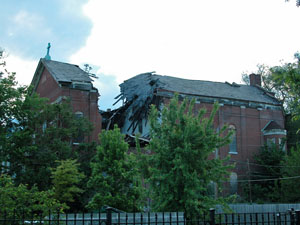 |
| Clemens House Chapel, Photo by Michael Allen |
This year saw the partial collapse of the chapel at the James Clemens House on May 15. A spokesman for Paul McKee's McEagle Properties, owner of the house, has told the media that there will be no demolition of the damaged chapel and that a sale may be in the works. This Spring, Landmarks' Assistant Director Michael Allen met at the Clemens House with a representative of Urban Solution, consultants hired by McEagle to implement a maintenance program for his over 700 north city properties. Landmarks is offering suggestions for short-term actions to secure and stabilize the buildings. Also, the mayor's office has asked Landmarks to help find a serious developer for the Clemens House-not an easy task in this market, but one made easier with what appears to be an opening of communication between McKee and preservationists.
The Clemens House leads into one of four new items on this year's list, selected because it embodies the potential loss should McKee's plans for North St. Louis proceed without preservation planning. To represent over 100 historic buildings in St. Louis Place, JeffVanderLou and Old North St. Louis owned by McKee's holding companies, we selected the elegant stone-faced Italianate house at 1930 St. Louis Ave in the Clemens House-Columbia Brewery Historic District.
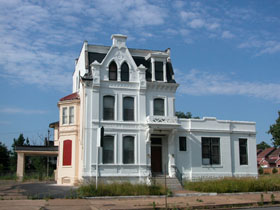 | 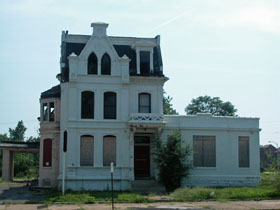 |
| Photoby Michael Allen, 2005 | Photo by Michael Allen, 2008 |
Built in 1873 as the home of wholesale grocer Bernhard Winkleman, the home served for many years as a funeral home until being sold to McKee in 2005. This building has mercifully escaped the brick thieves and arsonists who have destroyed many nearby unsecured vacant buildings, though it has seen significant decline in just the past few years. The above photos show damage that has taken place in the last three years evidenced by an increase in boarded windows, in addition to several that are completely open to the elements. Despite the pattern of demolition by neglect, we remain hopeful.
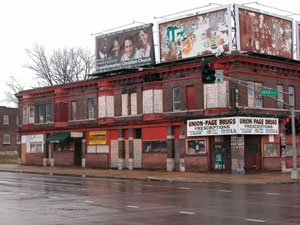 |
| 5286 Page, Photo by Michael Allen |
5286 Page. Another new addition to the list is the elegant two-story commercial building located at the southeast corner of Page and Union in the Mount Cabanne-Raymond Place Historic District. Built in 1905 and designed by George H. Kennerly, the building provides a pedestrian-scaled anchor at a prominent intersection formerly dominated by the Page Boulevard Police Station. Since last year, the neighboring Berean Seventh Day Adventist Church has owned the vacant commercial building, which has minor fire damage. Last fall, the church applied for a demolition permit that was denied by the Cultural Resources Office. A rancorous appeal process at the city's Preservation Board led to the board upholding the denial in January. Since that action, we have heard rumors ranging from a possible sale to a lawsuit against the Preservation Board. We had originally hoped to include this building in a grouping of endangered commercial buildings on Page Boulevard, but by the time we finalized this list the others had been demolished.
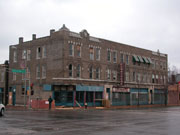 | 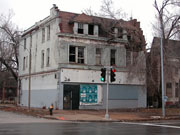 |
| 4972 Page, Demolished | 5100 Page, Demolished |
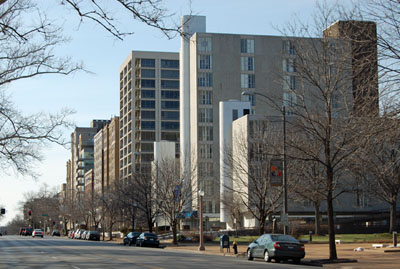 |
| San Luis Apartments, Photo by Andrew Weil |
Deville Motor Hotel (San Luis Apartments): 4463 Lindell. Prominent New Orleans architect Charles Colbert, FAIA, designed the Central West End's DeVille Motor Hotel, completed in 1963. Later known as the San Luis Apartments and owned by the St. Louis Archdiocese, the sparkling concrete building which lends mid-century modern flair to Lindell Boulevard's fine collection of early-twentieth century high rises is now under threat of demolition. The Archdiocese has relocated the DeVille's residents and plans to demolish it for a so-called "green" parking lot to serve the New Cathedral and Rosati-Kain High School. Needless to say, Landmarks is strongly against the demolition and is working to lobby the Central West End Association and Alderwoman Lyda Krewson to oppose placing a large surface parking lot on stately Lindell. The DeVille is eligible for listing on the National Register of Historic Places and boasts 180 built-in parking spaces, more than the proposed lot offers. Unfortunately, the designers of the "green" lot claim that the existing spaces are not large enough to accomodate today's vehicles.
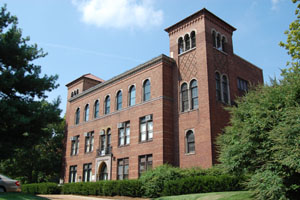 |
| Photos by Michael Allen and Andrew Weil |
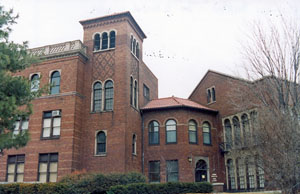 |
*Shriners Hospital (For Crippled Children): 700 S. Euclid. In 1921 the Shriners organization passed a proposal to create a network of free hospitals across the country to treat birth defects and crippled children. Their first hospital opened in 1922 in Shreveport, Louisiana. By the end of the 1920's 13 more hospitals had been built around the United States. The St. Louis facility, one of the first, was designed by renowned St. Louis Architect William B. Ittner. Construction of the Renaissance Revival building began in 1922 and the hospital opened in 1924. The building currently houses offices, though some interior spaces once used for hospital purposes pose a challenge for adaptive re-use. The building is threatened by a Community Unit Plan (approved) for the Washington University Medical Center which proposes, among other things, the possible demolition of several architecturally and historically significant buildings to make room for future expansion.
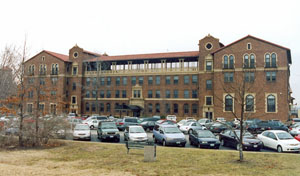 |
| Photos by Andrew Weil and Michael Allen |
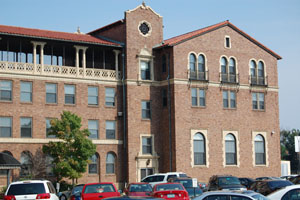 |
* Central Institute for the Deaf: 909 S. Taylor. Dr. Max Aaron Goldstein founded the Central Inststitue for the Deaf (CID) in 1914 and the first building opened in 1916 at the current location; Architect William B. Ittner expanded the building in 1929 to complement the neighboring Shriner's Hospital. Ittner maintained the Renaissance Revival style and added extensive laboratories, classrooms, and other facilities. The CID was initially envisioned as an institute to teach deaf children to speak and train teachers to deal with the special needs of the hearing impaired. In 1931, the CID Teachers Training College became the first deaf teachers college to be affiliated with a university when it created a partnership with Washington University. By 1947 the Institute offered graduate programs in deaf education, communication science, and the new field of audiology, which CID pioneered. In 1958, researchers and teachers implemented a parent-infant program that became a model for deaf education world wide. In 2000 the CID completed a new campus, which is a major addition adjoining the Ittner building to the east. The CID building was listed in the National Register in 2004. The building is threatened by the same plan that is entertaining the idea of demolishing the Shriners Hospital for a future expansion of the Washington Univeristy Medical Center.
* The Shriners Hospital Building and the Central Institute for the Deaf are grouped together as one, "Most Endangered" building due to their stylistic similarity, physical proximity, similar age, common architect, and shared threat.
